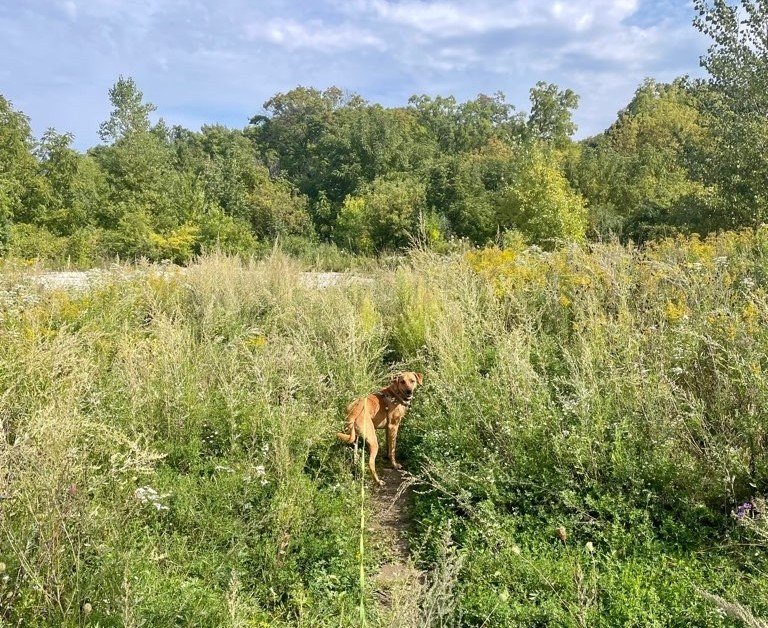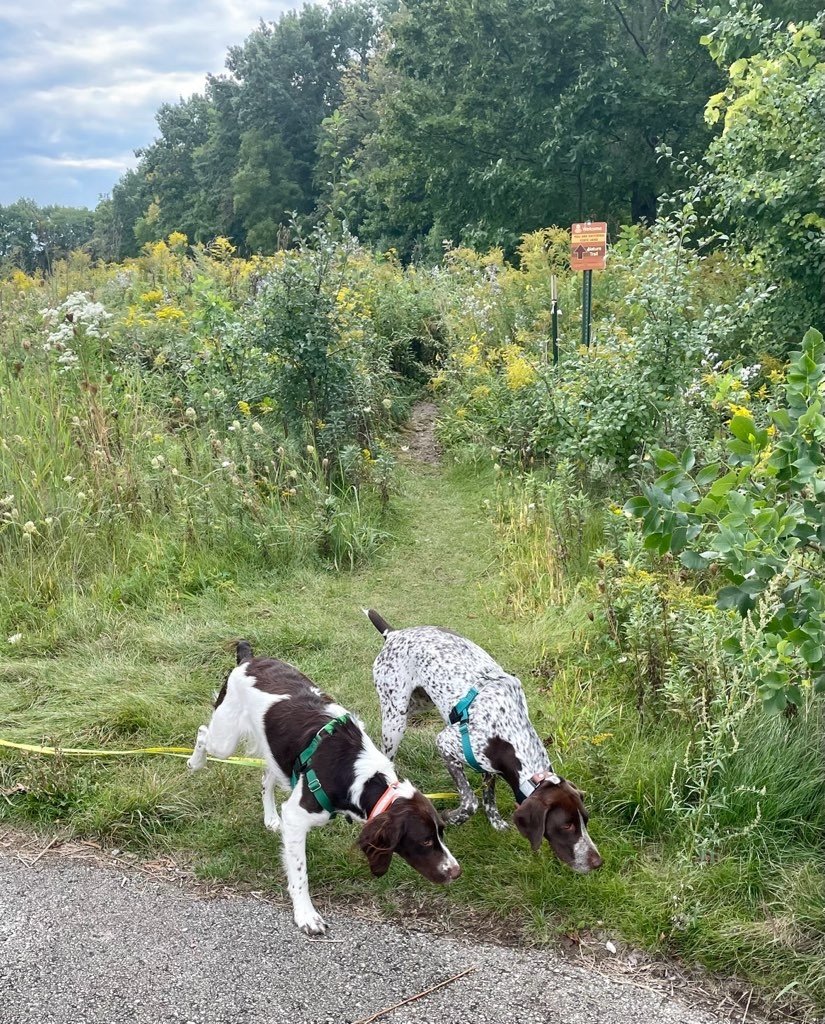Welcome back, dear reader! It's Marsha CPDT-KA, and this week I'll be exploring how understanding your dog's unique characteristics can help you tailor the perfect decompression walk experience for them.
Decompression walks hold a special significance for our canine companions, especially for those living in the hustle and bustle of urban environments. City life can be stimulating, but it also comes with its own set of challenges for dogs. The constant barrage of noises, the limited green spaces, and the sheer volume of people and other animals can overwhelm even the most resilient of dogs. Decompression walks serve as a much-needed escape from this sensory overload. They offer urban pups a chance to unwind, reconnect with nature, and engage in the instinctual behaviors that often get suppressed in city living. However, not all dogs are the same, and their breed and individual traits play a crucial role in determining their decompression walk preferences and requirements. Continue reading as we break things down and offer tips so you can customize a walk that best suits the dogs in your life.
The Importance of Decompression Walks
Before diving into the specifics, let's first understand why decompression walks are essential for every dog. These walks are, without a doubt, a cornerstone of a dog's well-being. Beyond just being a simple stroll, these walks are a lifeline for our furry friends. They provide a much-needed outlet for both mental and physical energy, akin to a daily meditation session for our beloved canines. Through these walks, dogs can shake off the stress of the day, release pent-up energy that might otherwise manifest as unwanted behaviors, and establish a deeper connection with their human companions. The great outdoors becomes their playground, their sanctuary of smells, sights, and sounds to explore, helping to satiate their innate curiosity and instincts. In essence, decompression walks are the keys to unlocking the best version of your dog, promoting physical fitness, mental agility, and the unbreakable bond that you share.
Breed Matters
Different breeds come with distinct temperaments, energy levels, and physical needs. Recognizing these breed-related traits can significantly impact how you plan and execute your dog's decompression walks. Here are a few things to consider:
High-Energy Breeds
High-energy breeds such as Border Collies, Labrador Retrievers, and Belgian Malinois thrive on physical and mental stimulation. For these breeds, a brief walk around the block simply won't cut it. They have abundant energy reserves that need to be expended, and they crave activities that engage both their body and mind. To cater to their needs, consider longer walks or hikes that offer plenty of opportunities for exploration and exercise. Incorporating games like fetch or frisbee can provide an excellent outlet for their boundless energy. Agility training is another fantastic option, as it challenges them both physically and mentally, keeping them engaged and satisfied. Opt for routes that feature varied terrain, such as trails with hills or wooded areas, as this adds an extra layer of excitement and mental stimulation for these energetic breeds.
Small Breeds
Small breeds like Chihuahuas and Pomeranians may have petite frames, but they still need their fair share of exercise and fresh air. These little companions may tire more quickly than their larger counterparts, so it's essential to tailor their walks to their physical capabilities. Instead of long, strenuous walks, opt for shorter but more frequent outings throughout the day. This not only helps them burn off energy without getting too fatigued but also allows for shorter bursts of excitement and exploration that they can handle. Additionally, pay close attention to weather conditions, as smaller dogs are more susceptible to extreme temperatures. During hot weather, schedule walks during cooler parts of the day to prevent overheating, and during cold weather, consider outfitting them with appropriate doggy attire to keep them warm and comfortable. Small breed dogs may require extra protection from harsh environmental conditions, ensuring their safety and enjoyment during walks.
Working Breeds
Working breeds like German Shepherds, Rottweilers, and Australian Shepherds are known for their strong work ethic and intelligence. To truly satisfy their need for mental stimulation during decompression walks, it's important to engage their minds as well as their bodies. While physical exercise is essential, these breeds thrive when they have tasks to complete or challenges to overcome. Consider incorporating training sessions into your walks, teaching them new tricks or reinforcing obedience commands. Puzzle toys that dispense treats can also be a fantastic way to keep their minds sharp and focused during walks. To mimic their natural inclination to work, you can have them carry a backpack filled with water bottles or other lightweight essentials. This not only provides them with a sense of purpose but also helps burn off excess energy, leaving them content and mentally fulfilled after each walk. For working breeds, a walk isn't just a stroll; it's an opportunity to engage their intellect and work ethic, creating a more balanced and satisfied canine companion.
Individual Traits Matter
While breed characteristics provide a general guideline, it's important to consider your dog's unique personality, abilities, and preferences.
Age
Age plays a significant role in tailoring decompression walks to meet your dog's needs. Puppies are bursting with boundless energy and curiosity, but their growing bodies need to be handled with care. While they may be enthusiastic, shorter and more frequent walks are advisable to prevent overexertion. Puppies can quickly tire out, so it's crucial to strike a balance between exercise and rest. On the other hand, senior dogs may not have the vigor they once had, and their joints and muscles may be more sensitive to strain. For these older companions, gentler, slower-paced walks with plenty of breaks are essential. These walks help keep them active without causing undue stress on their aging bodies. Regular, manageable exercise can help maintain their mobility and mental well-being while ensuring they enjoy their decompression walks well into their golden years.
Socialization
Socialization is a crucial aspect to consider when tailoring decompression walks for your dog. Just like people, dogs have diverse personalities when it comes to social interactions. If your dog is naturally outgoing and relishes meeting new people and other canines, opt for routes that offer opportunities for such interactions, such as paths that pass by dog-friendly parks or play areas. These sociable dogs benefit from the chance to make new friends and engage in playful interactions during their walks. However, if your dog is more reserved, shy, or anxious, it's essential to create a stress-free walking environment. Choose quieter trails or less frequented routes to minimize encounters with unfamiliar dogs and people. Gradually expose them to new experiences, but at their own pace, and consider obedience training to boost their confidence. Tailoring the walk to match your dog's social comfort zone ensures that they can enjoy their decompression walks without undue stress or anxiety.
Sensory Sensitivity
Sensory sensitivity is a vital aspect to consider during decompression walks, as dogs rely heavily on their extraordinary sense of smell and acute senses to interpret their surroundings. It's crucial to pay close attention to your dog's reactions to various scents, noises, and environmental factors during walks. Some dogs may be highly sensitive to strong odors, loud sounds, or busy environments. For these sensitive souls, choosing routes with fewer distractions is essential. Opt for peaceful, less congested trails or paths where the sensory input is milder, allowing your dog to explore without becoming overwhelmed. By carefully selecting a route that aligns with your dog's sensory preferences, you can ensure a more enjoyable and stress-free decompression walk that caters to their unique sensitivities, helping them relax and unwind in their own way.
Health Conditions
Health conditions can significantly impact your dog's ability to engage in decompression walks, and it's crucial to prioritize their well-being. Dogs with health issues, whether it's joint problems, heart conditions, or respiratory concerns, may have specific exercise limitations. Instead of trying to guess what's best for your furry companion, consult your veterinarian for expert guidance. Your vet can assess your dog's condition and provide recommendations on the type and duration of walks that are suitable and safe. They can help you create a tailored exercise plan that takes your dog's health into account, ensuring that your pet benefits from walks without risking any harm. By working closely with your veterinarian, you can help your dog stay active and content while managing their health concerns effectively.
Tailoring the Perfect Decompression Walk
Now that you understand how breed and individual traits can impact your dog's decompression walk needs, here are some tips to tailor the perfect experience:
Know Your Dog
Understanding your dog's preferences and behaviors is essential for tailoring decompression walks. Observe whether they are more interested in exploring new smells or sights and whether they enjoy brisk running or prefer a leisurely pace. Adapt the walks to cater to their specific likes and dislikes, ensuring a more enjoyable experience for both of you.
Variety is Key
Keep your dog engaged and excited by regularly changing up your walking routes. Exploring different terrains, visiting parks, and strolling through various neighborhoods not only provides physical exercise but also offers mental stimulation, preventing boredom and monotony during walks.
Exercise Their Mind
Mental stimulation is as crucial as physical activity, especially for high-energy breeds. Incorporate training sessions, obedience exercises, or interactive toys into your walks to challenge your dog's intellect. This mental engagement not only tires them out but also strengthens their problem-solving skills and enhances their overall well-being.
Watch the Weather
Extreme weather conditions can pose risks to your dog's health and comfort. Be vigilant about the weather, adjusting the duration and intensity of walks in response to hot or cold temperatures. During hot weather, opt for early morning or late evening walks to avoid the heat, and in colder weather, ensure your dog is appropriately dressed for warmth.
Stay Safe
Safety should always be a top priority during decompression walks. Use a leash and harness when necessary, and be mindful of traffic, other dogs, and potential hazards along the way. Being vigilant about safety ensures that your dog's outdoor adventures remain enjoyable and free from harm.
Every dog is a unique individual, shaped by a combination of breed traits and personal characteristics. Understanding these factors is key to tailoring the perfect decompression walks that cater to their needs for physical activity, mental stimulation, and socialization. By customizing your dog's walks, you can strengthen your bond and ensure that your furry friend enjoys every adventure outdoors. And if you're in the Milwaukee area, don't forget that Off Leash MKE offers personalized decompression walks to help your pup thrive in their unique way. So, the next time you take your pup for a walk, remember that different breeds have different needs, and it's your job to make their decompression walks a rewarding and enjoyable experience, with a little help from the experts at Off Leash MKE.










Off Leash MKE provides expertly designed decompression walks to help urban dogs unwind, reconnect with nature, and engage in instinctual behaviors that are suppressed in city living. Tailor the perfect walk experience for your pup today!